Microwave wattage shows how powerful your microwave is and how fast it heats food, measured in watts (W). Higher wattage means quicker, more even cooking, while lower wattage might need longer times. Knowing your microwave’s wattage helps you adjust recipes accurately and make the best use of it. Don’t assume wattage equals safety—proper use and maintenance matter more. Keep exploring to uncover more tips on choosing and optimizing your microwave.
Key Takeaways
- Microwave wattage indicates cooking power and speed; higher wattage means faster, more efficient heating.
- Wattage affects cooking time and recipe adjustments; use charts to modify times based on your microwave’s wattage.
- Most microwaves range from 600-1200 W; choose wattage based on your typical cooking and reheating needs.
- Higher wattage does not imply better safety or quality; proper use and maintenance are essential regardless of wattage.
- Misconceptions link wattage to safety or performance; understanding its true role helps in selecting and using your microwave wisely.
What Is Microwave Wattage and How Is It Measured?
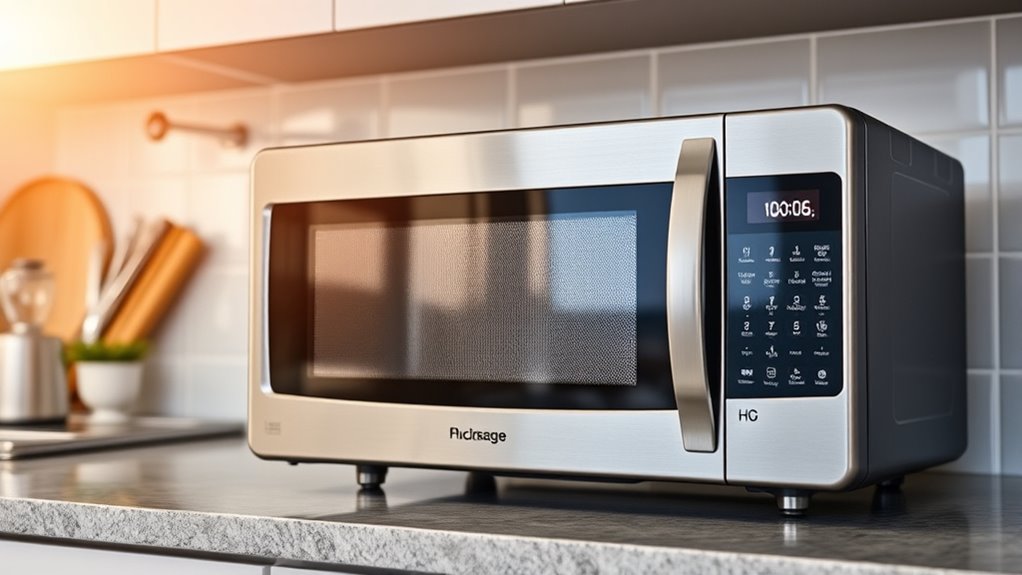
Microwave wattage indicates how powerful your microwave is and how quickly it can cook or heat food. It’s a key part of the energy measurement that determines its overall performance. Appliance ratings, which include wattage, help you compare different models and understand their capabilities. Wattage is measured in watts (W) and reflects the microwave’s energy output. Higher wattage means more power, allowing for faster cooking times and more efficient heating. Manufacturers specify wattage to give you a clear idea of the microwave’s strength. When you see a microwave’s wattage listed, it’s fundamentally a rating of its energy measurement capability. This rating helps you select a microwave that matches your cooking needs, whether you want quick reheating or slow, even heating. Understanding wattage can also help you optimize cooking times and ensure your microwave performs efficiently for your specific needs.
Why Wattage Matters When Cooking With Your Microwave
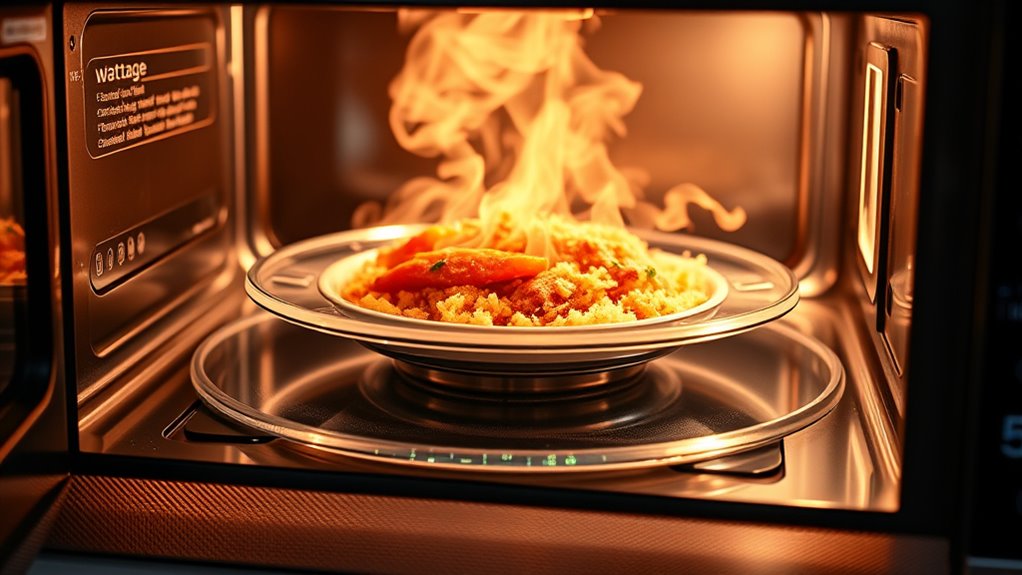
Wattage directly impacts how effectively your microwave cooks and heats food. Higher wattage means faster, more even heating, which can improve cooking efficiency and reduce the risk of undercooked spots. Conversely, lower wattage microwaves may require longer cooking times and careful attention to avoid uneven heating. This explicitly relates to microwave safety, as proper wattage ensures food reaches safe temperatures without overcooking or leaving bacteria behind. Additionally, kitchen appliance standards regulate wattage levels to maintain safety and performance, helping you select a microwave that meets quality benchmarks. Understanding why wattage matters helps you choose the right appliance for your needs, ensuring your food is prepared safely and efficiently. Ultimately, wattage influences both cooking performance and adherence to safety guidelines.
How to Find the Wattage of Your Microwave
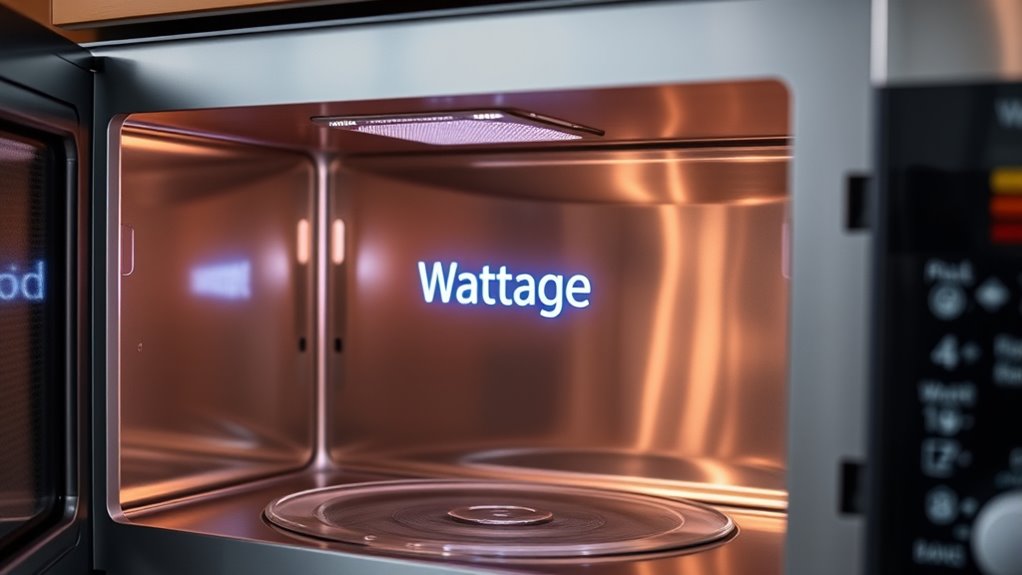
To determine the wattage of your microwave, start by checking the appliance’s label or sticker, usually located inside the door or on the back panel. This label provides essential information about the microwave’s power ratings, including its wattage, which indicates its energy consumption during operation. Knowing the wattage helps you understand how quickly your microwave can cook or reheat food. If you don’t see the information on the label, consult the user manual or visit the manufacturer’s website with your model number. The wattage directly relates to energy consumption, so higher wattage models typically cook faster but may use more electricity. Accurately identifying your microwave’s wattage ensures you use it efficiently and safely. Additionally, understanding the power ratings of different microwave models can help you choose the right appliance for your needs.
Understanding the Relationship Between Wattage and Cooking Time
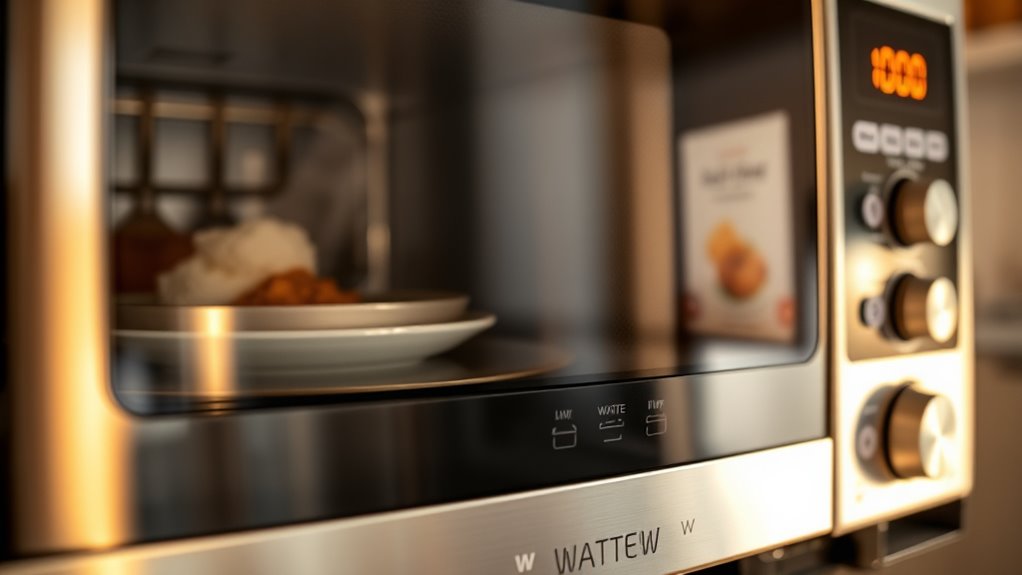
Since higher wattage models generate more power, they can cook or reheat food faster than lower wattage ones. This is because microwave energy is more efficient at transferring heat, reducing your overall cooking duration. When you use a higher wattage microwave, your food heats evenly and quickly, saving time. Conversely, lower wattage models require longer cooking times to achieve the same results, which can lead to uneven heating if not adjusted properly. To optimize your microwave use, consider these tips:
- Understand that cooking time decreases as wattage increases
- Use wattage-specific cooking charts for accurate timing
- Adjust your cooking duration based on your microwave’s wattage
- Always check food to prevent overcooking or undercooking
- Proper wattage ensures consistent cooking results. Knowing this relationship helps you better control microwave energy for faster, more consistent results.
Adjusting Recipes Based on Microwave Power Levels

Adjusting recipes for different microwave power levels is essential to achieving consistent cooking results. Without proper recipe customization, food might be undercooked or overdone. To do this effectively, you need to make power level modifications based on your microwave’s wattage. For example, if a recipe calls for high heat but your microwave operates at a lower wattage, you should reduce the cooking time or lower the power setting. Conversely, if your microwave is more powerful, increase the cooking time slightly. Always monitor your food the first few times you try these adjustments, so you can fine-tune your approach. Proper power level modifications ensure your dishes turn out just right, regardless of your microwave’s wattage. Knowing your microwave’s wattage is crucial for precise adjustments.
Common Wattage Ranges and What They Mean for Performance
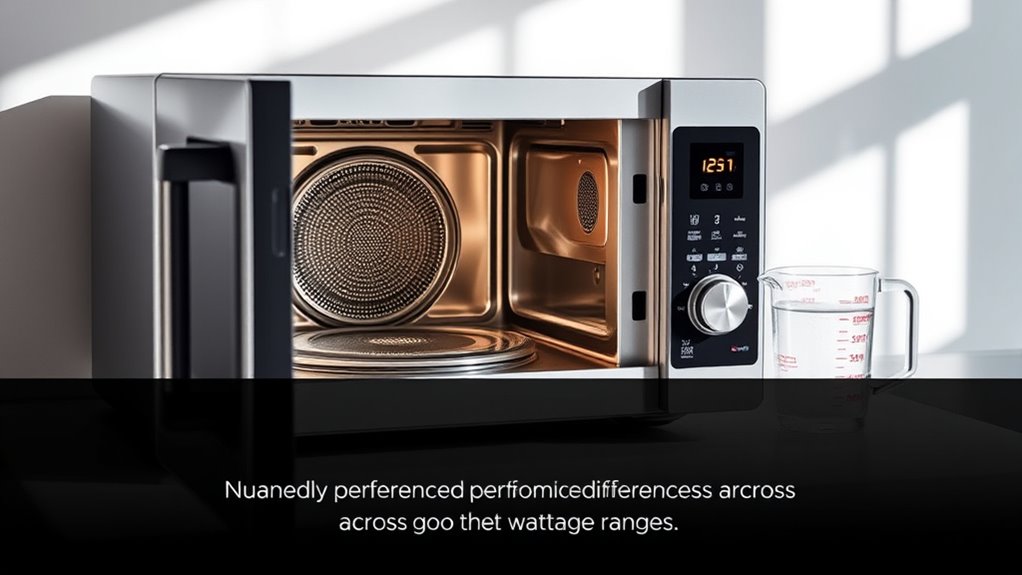
Most microwaves fall into common wattage ranges that directly affect how quickly and evenly your food cooks. Higher wattage models typically heat more efficiently, saving you time, while lower wattages may require longer cooking times. Understanding these ranges helps you choose the right microwave for your needs and cook more effectively. Additionally, selecting a model with appropriate net worth considerations can improve your overall kitchen investment and ensure optimal performance.
Typical Microwave Power Levels
Microwave power levels typically fall within a range of wattages that directly influence cooking performance. Most household microwaves operate between 600 and 1200 watts, with higher wattages providing faster, more efficient cooking. Lower wattage microwaves are suitable for gentle heating or defrosting, while higher wattage models excel at quick cooking and reheating. Understanding these levels helps you choose the right microwave for your needs. Some common power levels include:
- 600-800 watts: Ideal for slow heating and delicate tasks
- 800-1000 watts: Versatile for most cooking and reheating needs
- 1000-1200 watts: Best for quick cooking and efficiency
- Variable power settings: Allow fine control over cooking performance and food quality
Knowing these typical microwave power levels helps you optimize your microwave’s performance for better results. Additionally, considering the design and wattage of your microwave can influence how well it suits your specific cooking habits and kitchen space.
Impact on Cooking Efficiency
Higher wattage microwaves deliver more energy, which means faster cooking times and more efficient heating. When you choose a microwave with higher wattage, you’ll notice improved energy efficiency because it uses less time to reach desired temperatures, reducing overall power consumption. This efficiency not only saves you money on electricity bills but also minimizes heat waste. Microwaves with wattages between 700 and 1000 watts typically provide good performance for most home needs, balancing power consumption with cooking speed. However, higher wattage models, around 1200 watts or more, excel in quick, even heating, especially for larger or denser foods. Overall, selecting the right wattage impacts how effectively your microwave converts electrical energy into heat, directly influencing cooking efficiency and energy use. Understanding wattage helps you choose the best appliance for your needs.
Tips for Choosing a Microwave With the Right Wattage
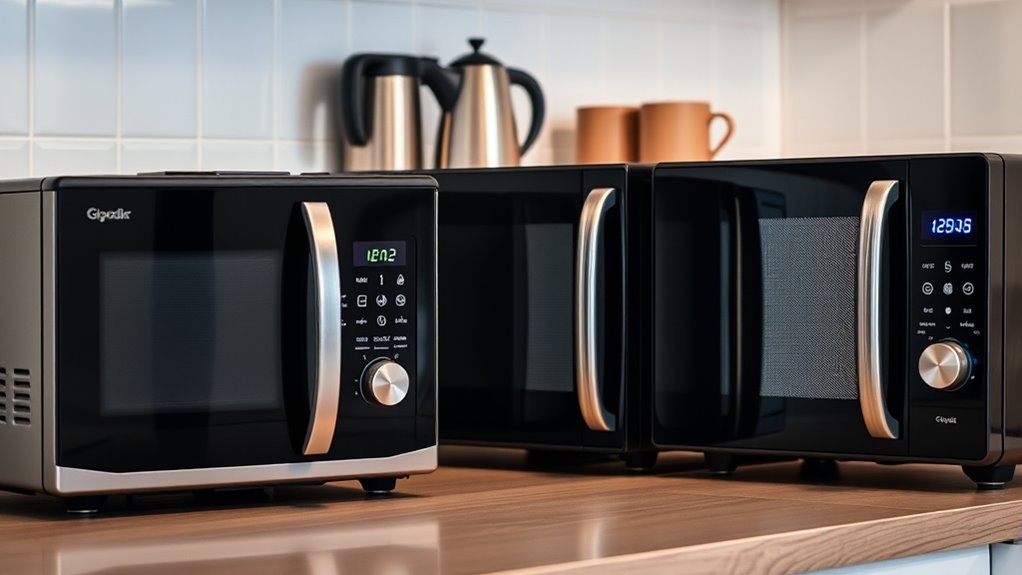
When choosing a microwave with the right wattage, it’s important to contemplate how you plan to use it most often. Higher wattages cook faster but may consume more energy, impacting energy efficiency. Lower wattages are gentler and safer, ensuring better microwave safety for everyday use. To select the best options, consider these tips:
Choose the right microwave wattage for efficiency, safety, and everyday convenience.
- Match wattage to typical meal sizes and cooking tasks
- Opt for moderate wattage (700–900W) for balanced speed and energy efficiency
- Check for safety features that prevent overheating or mishaps
- Prioritize user-friendly controls for precise power adjustments
- Understanding microwave wattage can help you optimize your coffee and home appliances for a more efficient and enjoyable kitchen experience.
Myths and Misconceptions About Microwave Wattage
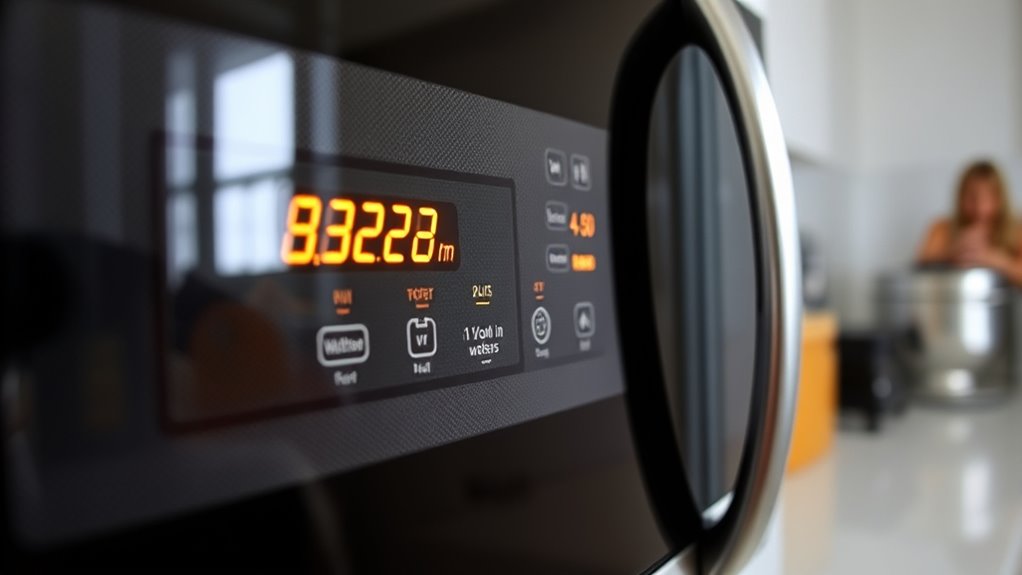
Many people believe that a microwave’s wattage directly determines its overall quality or cooking ability, but this isn’t entirely true. Wattage myths often lead to the misconception that higher wattage means better microwave safety or faster cooking. In reality, wattage affects cooking speed, but other factors like design, turntables, and features matter just as much. Some think lower-wattage models are unsafe or less reliable, which isn’t true—wattage doesn’t impact safety if the microwave meets standards. Remember, a microwave’s safety isn’t about wattage but proper use and maintenance. Cookies and privacy considerations also play a role in your overall experience with appliances and websites. Don’t fall for wattage myths that oversimplify microwave performance; understanding the actual role of wattage helps you choose a safe, efficient appliance suited to your needs.
Frequently Asked Questions
Can Higher Wattage Cause Uneven Heating in My Microwave?
Higher wattage can sometimes cause uneven heating in your microwave because it delivers more power quickly, leading to hot spots. This affects microwave power and heating uniformity, making certain areas hotter than others. To avoid this, stir or rotate your food frequently and use microwave-safe covers to distribute heat evenly. Adjusting power levels or using a lower wattage setting can help improve overall heating uniformity.
Does Microwave Wattage Affect Energy Consumption?
Yes, microwave wattage affects energy consumption. Higher wattage models use more energy per minute, but they cook food faster, potentially saving you energy overall. Choosing the right wattage can also extend your appliance’s lifespan by reducing wear and tear from prolonged use. To maximize energy savings, select a microwave with appropriate wattage for your needs, and avoid running it longer than necessary, which helps keep costs down and your appliance healthy.
Are Lower Wattage Microwaves More Energy-Efficient?
Lower wattage microwaves can be more energy-efficient because they use less power overall, leading to potential energy savings. However, they might take longer to cook your food, which could offset some efficiency gains. If you’re looking for better power efficiency and want to reduce energy costs, choose a microwave with appropriate wattage for your needs. Always consider cooking time and energy use to maximize energy savings.
How Does Wattage Influence the Durability of Microwave Components?
Wattage’s weighty influence impacts microwave component longevity. Higher wattage generates greater thermal stress, straining parts faster and risking damage. Conversely, lower wattage keeps components cooler, promoting prolonged durability. You’ll notice that managing wattage levels helps prevent overheating and reduces wear and tear. By controlling wattage, you protect your microwave’s internal components, ensuring they endure longer, perform better, and resist the relentless rush of thermal stress.
Is There a Safety Risk Associated With Very High Wattage Microwaves?
High wattage microwaves aren’t inherently unsafe if you follow proper appliance safety. They emit microwave radiation, but modern models are designed with safety features to prevent leaks or exposure. As long as you use the microwave correctly, avoid tampering with safety mechanisms, and keep the door seals intact, there’s no significant safety risk. Always read the user manual to ensure safe operation regardless of wattage.
Conclusion
Understanding your microwave’s wattage is like revealing a secret language—it helps you cook smarter, not harder. By recognizing how wattage influences your results, you can navigate your kitchen with greater confidence. Remember, it’s not just about numbers, but the harmony between power and time. Embrace this knowledge gently, and your microwave will become a trusted partner in creating delicious meals effortlessly. Cooking becomes more about art, guided by your newfound understanding.










